I suppose I am a curator by nature. People’s stories call to me, and I am charmed when I discover that an object has a story behind it.
Right now, before you are a moment older, think about what you have that holds someone’s story.
An object is lifeless, but connect it to a meaningful experience, and it can evoke the experience, the times, and the people who were there. It comes to life.
You couldn’t tell, looking at these rocks, why they matter:
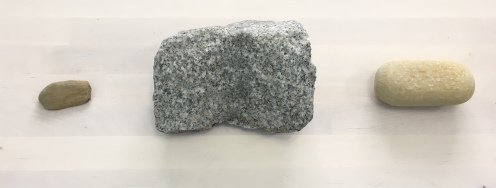
But each of these rocks takes me to a special place in memory.
I picked up the first on a hike in the Swedish mountains. Reaching the top, where we could see clear to Norway, was the exhilarating culmination of a twenty-year dream. I didn’t discover the fish fossil on its other side, until I was home.
The second is from Emilie Loring’s granite quarry, the same granite that made her Stone House. In my next garden, I want a trickle of water to flow across it into a pool of clear water, ringed with ferns.
“Rod’s mother loved every inch of the land, turned the abandoned quarry holes into gardens.” …Water rilled gently over a ledge to tinkle into a fern-rimmed pool.
Hilltops Clear
The last rock is truly dear. When my children were small, we used to go to Sister Bay in Door County, Wisconsin and throw beach rocks into the water. This one caught our eye–“It looks like a baked potato!”–and Potato Rock it has been, ever since. (My daughter has already called “dibs” for it, after I die.)
If you want to help one generation’s stories to carry on to the next, here are some ideas that have helped me:
Learn
Maybe you know the story, maybe you know part of it, or maybe you’ll have to do some digging first. I love this part; there is such excitement in a mystery you get to unravel.
Make a copy
Originals may be saved and treasured, but it takes just one tornado, one flood, fire, or a relative who wants to downsize, and away they go, forever. Make copies!
Artifacts: Store, display, or pass them along, but first, photograph each item, and record its story.
You can use a fancy light box or your trusty cell phone, just take a photograph and label either a printed copy or the digital file with all pertinent information.
Photographs and documents: Scan or photograph them as well as you can (no flash), label the print or digital file, and record its story.
My first efforts with a digital camera were pitiful, and I missed out on important images that any cell phone today would have gathered easily. Don’t let that happen to you. Use a tripod, if you can (no shake!), and watch out for parallax (distorted, crookedy pictures!). Set your camera’s timer, press the button, and step back for shake-free photos. If you want to go “retro,” traditional negatives preserve detail wonderfully and last for ages.
If you scan instead, use the color setting, even if it’s a black-and-white original. More detail will be preserved. And use the highest resolution you can. Try for 600 dpi or better. The greater the resolution, the better you will be able to zoom in on details that may matter to you later on.
I have a flat-bed scanner for home use, but when I travel, I often take along a Flip-Pal mobile scanner. It operates like a mini-flatbed scanner, or you can take the lid off and turn the whole unit upside-down on top of photos in a relative’s picture album. It can even handle over-sized items by taking overlapping single scans and “stitching them together” with the included software. The charcoal portrait of my great-grandparents was copied that way; the original is at least 18″ x 24″.
(To learn more, listen to Tom Perry, Preservation Authority, on the “Extreme Genes” Podcast.)
Family stories: Don’t count on oral tradition. Write them down.
I remember conversations with my Great-aunt Esther and my Grandma Bender, who were the family story-keepers of their generation. I can see them in my mind’s eye, clear as day, and I can hear the sounds of their voices, their tone and accents. But, for the most part, what I remember is having the conversations; I don’t remember what was said.
My parents both wrote autobiographies, which are amazing treasures, but Dad’s stopped at the year I was born. “You know the story after that,” he said. But of course, we girls didn’t. We ate Aunt Esther’s homemade donuts, followed Grandma’s household rules, and lived with our parents every day, but we didn’t pay attention to their lives; we paid attention to our own.
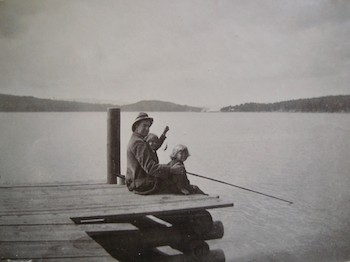
The same was true for the Loring grandchildren. They had memories, of course, but they were children’s memories–the oranges they got for Christmas, the year Grandmama brought them a dog, the Hallet sisters’ driver who wore spats. Children’s memories are precious; be sure to record them! Then find the people who remember what the grown-ups were doing.
Remember to record your own stories, too. After all, who knows them better than you?
Don’t worry too much about how you get it down, just do it. Write verbatim, take notes, record, videotape–whatever is handy, whenever you can. Cell phones have easy recording capability, or you can invest in a small tape recorder and omni-directional microphone. Be sure to give it a test run before you record anything important!
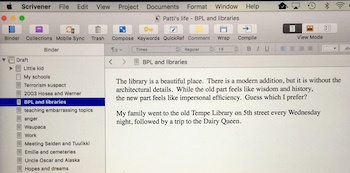
Whatever your method, save printed transcripts in a notebook with tabs to keep them organized. A software program called Scrivener lets you type little bits of stories, rearrange them as easily as you would note cards, and print them out as a Word document whenever you want. It doesn’t matter what tool you use; if the words are recorded and can be found when you want them, you’ve done the job.
Don’t forget NOW. This generation is one of the most recorded, most photographed in history, but turn off the electricity, and what do you have? Print out some of those texts and emails. Make physical copies of photographs. Technologies continue to change, but books, documents, and print photographs have a pretty good track record.
Share the stories!
“Histories we keep, stories we share.” We’ve done the keeping, now let’s share!
In person:
I love to get together and tell stories with people who share a history. This happens naturally. The only thing I would suggest is to have something visual with you that can symbolically “hold” the story and trigger memories of it in the future.
Books:
Of the permanent projects, my favorite is a book. I have made a bunch of them, and my favorite company is Mixbook. Their interface is intuitive, SO easy to use; the quality of paper and images is excellent; and they have given me over-the-top customer service.
Books that are mostly pictures with just enough text to tell a little story are easy to make. Upload your photos, arrange them on the page, and add text. Done. Next page…
Website:
I never thought I would create a website, but now that I have, I recommend it, especially if your audience is spread to the winds, like my friends and family. A website gives your group a central “gathering place.” You can add photos and stories whenever you want, and others can contribute or comment.
Websites can be public (like this one), or shared only with people you invite. A basic website with WordPress is free, and I can vouch that the experience is pretty seamless, with good tech support (“Happiness Engineers”). I used a book to get started, because I was truly a newbie, and I keep a private website on the side where I experiment with formatting ideas before using them here.
Playing cards? What?!
I tried something new this past Christmas that I’ll throw out for you to play with: I created a deck of playing cards to share family photos, artifacts and traditions.
Each suit was a grandparent’s line, black cards for men, red for women. Grandpa Bender’s suit was spades, Grandma Bender’s was diamonds. Grandpa Johnson’s suit was clubs, Grandma Johnson’s was hearts. Aces were my parents, Jacks were grandparents, Kings and Queens were great-grandparents, and Jokers were the oldest people we had photos for. Numbered cards were anything we associate with that line of the family.
Each card had a picture and a short caption: “Irish Nelly Murphy,” “Dad played saxophone in the marching band.” The reverse was a picture of Forget-Me-Nots from our lakeshore.
Here’s how they looked:
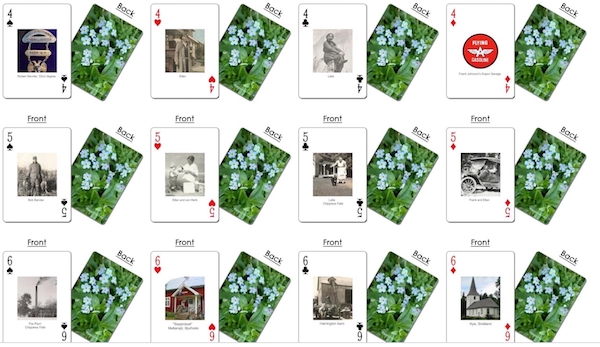
I gave cards to my mom, sisters, and to all of my nieces and nephews. They can use the cards, whether they are interested in family history or not, but my hope is that the photos will make them curious. Maybe some conversations will begin, and stories will be told!
Where we began:
(If you haven’t read it, Part I is here.)
Time goes forward, some memories get left behind, and some scatter to the winds until someone takes the time to find them.
Could you save someone’s story and pass it along? Don’t wait too long…
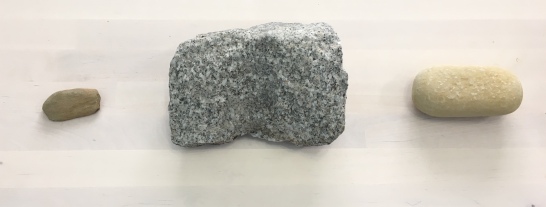
Please share this post.






















Thank you for sharing this conversation. I love the idea of the cards. Brilliant! I am in the process of writing about our family for our children. My husband became ill 17 years ago Nd I have been his caregiver. The circumstances have been difficult but I wanted them to know how we arrived at who we are now , and how the family of the past influenced us today. Interesting at what I had forgotten until I see old photos that trigger a memory. My children have a child’s perception of the facts which is quite eye opening. It’s fun. I wish you well in your writing. Aloha pam
Sent from my iPad
>
LikeLiked by 1 person
I so respect you for your caregiving and also for passing along your story. My father was all set to attend the Naval academy but got polio. As he wrote for us in his autobiography, “It meant a change of plans.” So many of us have events that change our plans and transform our lives. I am glad you have your art, something for yourself.
LikeLike
Hi, Patti! I tell my kids stories, like my mom, aunts and Grandmother being at Bonnie Parker’s funeral. The revolutionary ancestor. Silly little bits sometimes, but I have hopes they will tell their children.
LikeLiked by 1 person
So interesting! One of my grade school friends, a “Barrow,” was Clyde Barrow’s niece… or cousin? Anyway, she brought a family photo album to school with his photo in it. Such cool stories families have!
LikeLike
Have great success Patti
Skickat från min iPhone
> 21 feb. 2018 kl. 04:50 skrev The Emilie Loring Collection : > > >
LikeLike